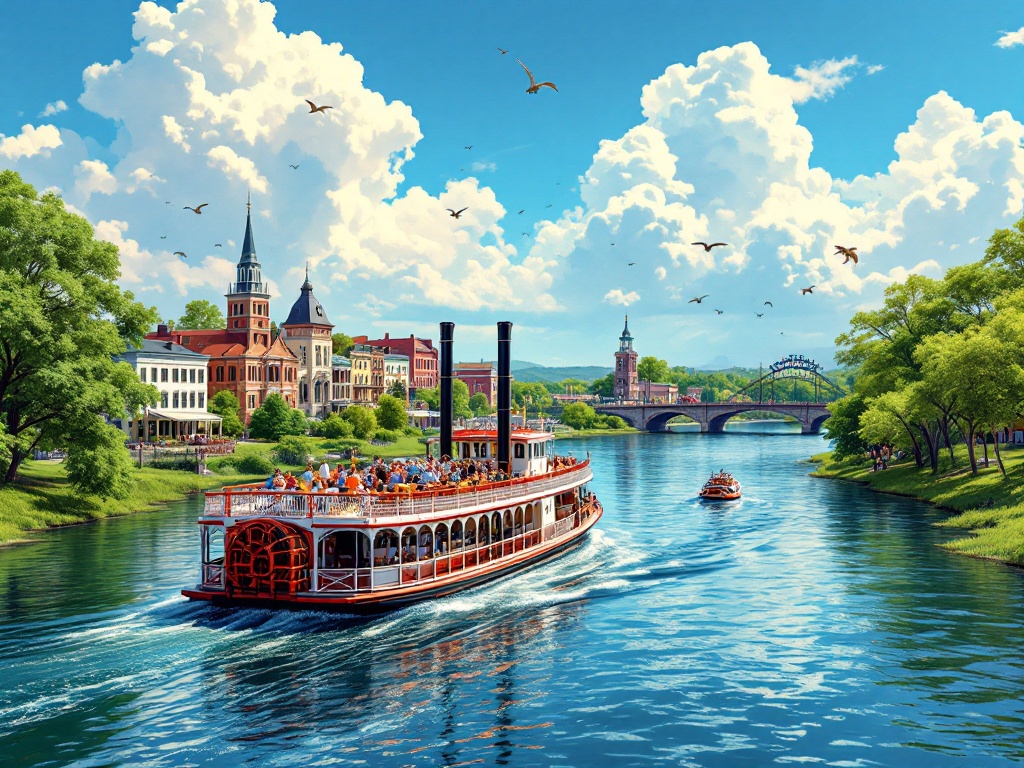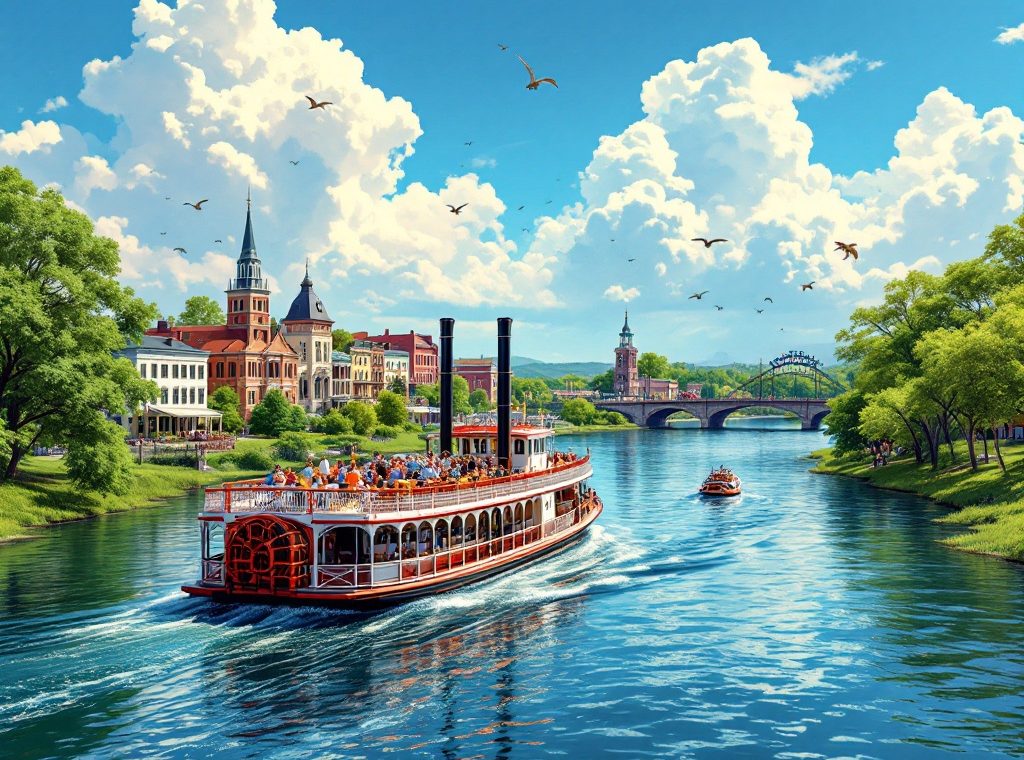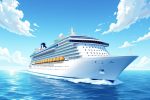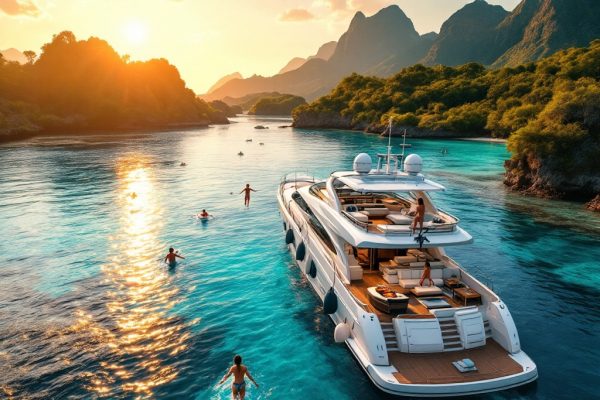Can You Travel the Mississippi River by Boat?
Embark on an unforgettable journey down the mighty Mississippi River, North America’s second-largest drainage system! Spanning 2,320 miles from Minnesota’s Lake Itasca to the Gulf of Mexico, this iconic waterway offers diverse experiences. Discover historical sites, vibrant port cities, and abundant wildlife. Explore the river by paddlewheeler, houseboat, or kayak, tailoring your adventure to your style. Plan your Mississippi River trip today and unlock the heart of America!
Important information

- The Mississippi River flows 2,320 miles from Lake Itasca in Minnesota to the Gulf of Mexico, traversing ten states.
- It’s a crucial waterway for trade, transportation, and recreation, supporting a diverse ecosystem.
- Various boats, from paddlewheelers to kayaks, can be used to navigate the river.
- Careful trip planning is essential, including checking river conditions, weather forecasts, and lock sizes.
- Safety is paramount: use life jackets, navigation tools, and communication devices; be aware of currents and river traffic.
Understanding the Mississippi River
The Mississippi River, a major North American waterway, forms the heart of the continent’s second-largest drainage system, surpassed only by the Hudson Bay system. Originating at Lake Itasca in northern Minnesota, this vital river flows 2,320 miles south to its final destination: the Gulf of Mexico’s Mississippi River Delta. It serves as a crucial channel for trade, transportation, and recreation.
The Mississippi River’s Course
From its source in Lake Itasca, Minnesota, the Mississippi River embarks on a remarkable 2,320-mile journey south to the Gulf of Mexico. This vital waterway traverses ten states:
- Minnesota,
- Wisconsin,
- Iowa,
- Illinois,
- Missouri,
- Kentucky,
- Tennessee,
- Arkansas,
- Mississippi, and
- Louisiana.
Importance of the Mississippi
The Mississippi River plays a crucial role in commerce, serving as a primary artery for the transportation of agricultural and industrial goods, as well as other essential commodities. Beyond its commercial significance, the river is vital for tourism and recreational activities, including boating and fishing.
Geography and Stretch
The Mississippi River flows over 2,350 miles from its source at Lake Itasca, Minnesota, to the Gulf of Mexico. It passes through ten states: Minnesota, Wisconsin, Iowa, Illinois, Missouri, Kentucky, Tennessee, Arkansas, Mississippi, and Louisiana. The Mississippi River Basin, a vast network encompassing thirty-one states and two Canadian provinces, further expands the river’s reach.
Significance as a Waterway
The Mississippi River is a crucial transportation artery for the US, carrying agricultural and industrial products, as well as people. This vital waterway fuels a thriving economy and supports a diverse ecosystem, providing habitat for a rich variety of plants and animals. The Mississippi River is truly an American treasure.
Types of Boats for Traveling the Mississippi River
Experience the grandeur of the Mississippi River aboard a classic paddlewheeler. These refurbished steamboats boast modern amenities such as restaurants, lounges, and live entertainment, all while preserving the charm of a bygone era.For a more immersive experience, choose a houseboat. These floating accommodations offer the comforts of home, including kitchens and spacious decks perfect for enjoying the scenic riverbanks.If adventure calls, explore the Mississippi’s diverse waterways with a variety of personal watercraft.
Motorboats offer speed and flexibility, allowing you to navigate the river at your own pace.
Kayaks provide a peaceful way to explore calm backwaters and tributaries, getting you closer to nature.
Jet skis deliver an adrenaline rush as you glide across the water, ride the currents, and experience the river’s raw power.
Riverboats and Paddlewheelers
Riverboats and paddlewheelers evoke romantic images of Mississippi River voyages, offering a nostalgic glimpse into the past. Modern vessels seamlessly blend this old-world charm with contemporary comforts, creating a unique travel experience.
Houseboats and Personal Watercraft
Embark on extended Mississippi River adventures with comfortable houseboats equipped with all the essential amenities. For personalized thrills, explore the river at your own pace with personal watercraft like jet skis and small motorboats.
Kayaks and Jet Skis for Adventure
Experience the tranquility of the Mississippi by kayak. Observe wildlife up close on a peaceful journey through its stunning waters.
For an adrenaline rush, speed across the Mississippi on a jet ski. Feel the wind in your hair as you take in breathtaking views of the river and surrounding scenery.
Planning Your Mississippi River Trip
Planning a Mississippi River trip is an exciting endeavor that requires careful preparation. Several key steps will ensure a smooth and enjoyable journey.
Research your route, taking into account your desired trip length and the sights you wish to see. The Great River Road, a network of highways running along the Mississippi River, offers scenic access points for embarking on your adventure.
Assess your boating skills honestly and choose a vessel appropriate for your skill level and the river conditions. Be aware of river currents, water levels, and potential hazards.
Consult navigational charts and check for updates from the U.S. Army Corps of Engineers. Staying informed about river conditions is crucial for safe navigation.
Pack essential safety gear, including life jackets for all passengers, communication devices such as a VHF radio or satellite phone, and a well-stocked first-aid kit. Being prepared for emergencies is paramount.
Check weather forecasts regularly before and during your trip. Be prepared to adjust your plans as needed based on changing weather conditions. Safety should always be your top priority.
Enjoy your Mississippi River adventure!
Route Planning and Navigation
Navigating the Mississippi River requires meticulous planning. Several key factors contribute to a safe and successful journey. Understanding the river’s currents, depths, and potential obstacles is crucial. Navigational aids, including buoys, markers, and charts, are essential tools for safe passage. While modern technology like GPS and electronic charts offers pinpoint accuracy, traditional tools such as a compass and river charts remain invaluable. A deep understanding of the river itself is paramount for successful navigation.
Challenges and Safety Considerations
River conditions and weather patterns are dynamic, making safety paramount for a successful trip. Fluctuating water levels, shifting currents, and debris create navigational hazards. Fog, storms, and strong winds can further complicate matters. Mitigate these risks by using essential safety equipment, especially life jackets. Navigation tools and communication devices are also crucial. Furthermore, maintain awareness of river traffic, adhere to navigation rules, and monitor weather forecasts.
Understand that river conditions and weather patterns are dynamic. These changing elements make safety extremely important for a successful trip.
Be aware of fluctuating water levels, shifting currents, and debris. These factors can create navigational hazards.
Consider that fog, storms, and strong winds can complicate matters further. Be prepared for unexpected changes in weather.
Mitigate these risks by using essential safety equipment, especially life jackets. Ensure everyone on board is wearing a properly fitted life jacket.
Utilize navigation tools and communication devices. These are crucial for staying on course and contacting help if needed.
Maintain awareness of river traffic, adhere to navigation rules, and monitor weather forecasts. Planning and preparation are essential for a safe and enjoyable experience.
Anchorage and Dockage Options
Secure your boat at marinas, public docks, or private moorings. Another option is anchoring, but always verify local regulations beforehand. Some areas are designated for anchoring. Others, such as shallows, strong currents, or areas with heavy commercial traffic, are prohibited for safety reasons. Prioritize a safe and enjoyable experience by consulting local guidelines and river charts.
Camping and Places to Stop
From established campgrounds to secluded wilderness sites, there’s a camping experience for everyone. Seeking something special? Explore the historical Effigy Mounds National Monument or the scenic Pikes Peak State Park, both popular destinations. For those traveling by water, numerous marinas and river towns offer overnight dockage. These include Hannibal, Missouri, and Memphis, Tennessee. Many other riverside locations also cater to boaters’ needs.
Excursions and Historical Sites
A Mississippi River journey unveils captivating history. Vicksburg National Military Park and the Chalmette Battlefield are essential stops, but the river’s riches extend beyond battlefields. Explore Mark Twain’s boyhood home in Hannibal, Missouri, or delve into blues history at Clarksdale, Mississippi’s Delta Blues Museum. These cultural landmarks add depth and educational value to any river voyage.
Cruising the Mississippi River
Experience the diverse character of the mighty Mississippi River, journeying through its distinct upper, middle, and lower sections. From its source to the Missouri River, the Upper Mississippi enchants with scenic beauty and abundant wildlife. The Middle Mississippi, stretching from the Missouri to the Ohio River, showcases the river’s strength and industrial significance. Finally, the Lower Mississippi, flowing from the Ohio to the Gulf of Mexico, reveals agricultural richness and vibrant port cities. Each section offers a unique perspective, creating a comprehensive Mississippi River adventure.
Renowned Cruise Lines
Several renowned cruise lines offer captivating Mississippi River itineraries, including:
- American Cruise Lines.
- American Queen Voyages.
- Viking River Cruises.
Whether you’re a history buff, a culture enthusiast, or simply seeking leisurely sightseeing, there’s a cruise to match your interests.
Best Time to Cruise
Spring and fall typically provide the most pleasant weather and fewer crowds for a Mississippi River cruise. However, each season unveils its own distinct charm.
River and Weather Conditions
River and weather conditions play a crucial role in your cruise experience.
High Water Impact
High water can restrict access to certain areas.
Low Water Impact
Low water may impact navigation.
Check Forecasts
Checking river forecasts and staying updated on weather conditions before and during your trip is vital for a smooth and enjoyable journey.
Exploring the Upper, Middle, and Lower Mississippi
The Upper Mississippi River flows from Minnesota to Cairo, Illinois, offering stunning scenery and abundant wildlife. Its well-known locks and dams allow large ships to navigate the river.
From Cairo to Baton Rouge, the Middle Mississippi showcases historic towns, cultural landmarks, and where the Ohio River joins. Lastly, the Lower Mississippi, from Baton Rouge to the Gulf of Mexico, offers a wilder, more secluded trip through unique delta landscapes.
Popular River Cruises and Main Cruise Lines
Experience the timeless allure of the Mississippi River aboard a classic paddlewheeler with American Queen Voyages.
Alternatively, embrace modern sophistication on a sleek riverboat with American Cruise Lines.
Both lines provide diverse itineraries, ensuring a perfect match for your travel preferences.
Best Seasons for Cruising
Spring and fall offer the most comfortable temperatures for a Mississippi River cruise, avoiding summer’s intense heat and humidity. Autumn further enhances the experience with the vibrant beauty of fall foliage, making it a particularly stunning time of year for a river cruise.
Impact of Weather and River Conditions
River conditions significantly impact your cruise experience. High or low water levels, swift currents, and floating debris can create navigational challenges and affect safety. Weather, including heavy rain or droughts, influences water levels, potentially causing itinerary changes or delays. Strong winds can exacerbate these issues by generating hazardous currents. For a smooth and enjoyable cruise, monitor weather forecasts and river conditions before and during your trip. Here’s a breakdown of how these factors can affect your cruise:
Water Levels
High water levels can submerge docks and landmarks, restricting access to certain areas. Conversely, low water levels may expose rocks and sandbars, making navigation difficult.
Currents
Swift currents pose challenges for maneuvering vessels, especially in narrow channels. Strong winds can amplify these currents, creating hazardous conditions.
Weather
Heavy rain can lead to rising water levels and flooding. Droughts can result in low water levels, impacting accessibility.
Debris
Floating debris, such as logs and branches, can obstruct waterways and damage vessels.
Check weather forecasts and river conditions before your cruise. This allows you to anticipate potential issues and pack accordingly.
Stay informed about river conditions throughout your journey. Conditions can change rapidly, so regular updates are crucial.
Follow instructions from cruise staff regarding safety procedures. They are trained to handle various river conditions and emergencies.
Unique Experiences on the Mississippi
Embark on a scenic Mississippi River cruise and encounter its diverse wildlife. Observe majestic bald eagles soaring overhead and watch herons and pelicans skillfully hunt for fish. The river teems with numerous waterfowl and shorebirds. Along the riverbanks, you might glimpse river otters, beavers, and deer. The Mississippi’s vibrant ecosystems offer a truly remarkable experience.
Scenic Sailing and Wildlife Observation
A Mississippi River sailing trip offers breathtaking scenery, from towering bluffs to lush wetlands. It’s a visual feast, complete with opportunities to spot wildlife such as bald eagles soaring overhead, herons, and pelicans wading in the shallows. The river teems with diverse fish species, further enriching any journey along this natural wonder.
FAQs About Traveling the Mississippi River by Boat
Navigating the Mississippi River: Key Considerations for Vessel OperatorsWhile U.S. Coast Guard regulations don’t impose vessel size limits on the Mississippi River, lock dimensions do restrict passage. Lock sizes vary significantly; for instance, Ohio River locks typically measure 600 feet by 110 feet. Tributary locks are often smaller, so always verify lock sizes along your planned route before embarking on your journey.
Currents and Navigation
Mississippi River currents fluctuate considerably, requiring you to check current conditions and forecasts. Stronger currents generally run mid-river, while weaker flows exist near the banks. Be mindful of commercial traffic and the wakes of larger vessels, which can impact your navigation.
Communication and Safety
Utilize your VHF radio to communicate with other river traffic and maintain a safe distance. Exercise added caution and reduce speed when navigating narrow channels and bends in the river. These areas often have unpredictable currents and limited visibility.
What Are the Vessel Dimension Requirements?
Mississippi River vessels face size restrictions, including length, width, and draft. These limitations vary by river section and vessel type. For detailed information, contact the U.S. Army Corps of Engineers.
How to Handle River Currents and Traffic?
Understand your speed and direction to navigate safely.
Consult river charts and navigational aids, especially when approaching bends or areas with limited visibility.
Maintain a safe distance from other vessels and use your horn to signal your presence. Be mindful of larger commercial traffic.
Adapt your course and speed as necessary to accommodate changing conditions, such as strong currents or unexpected weather shifts.














